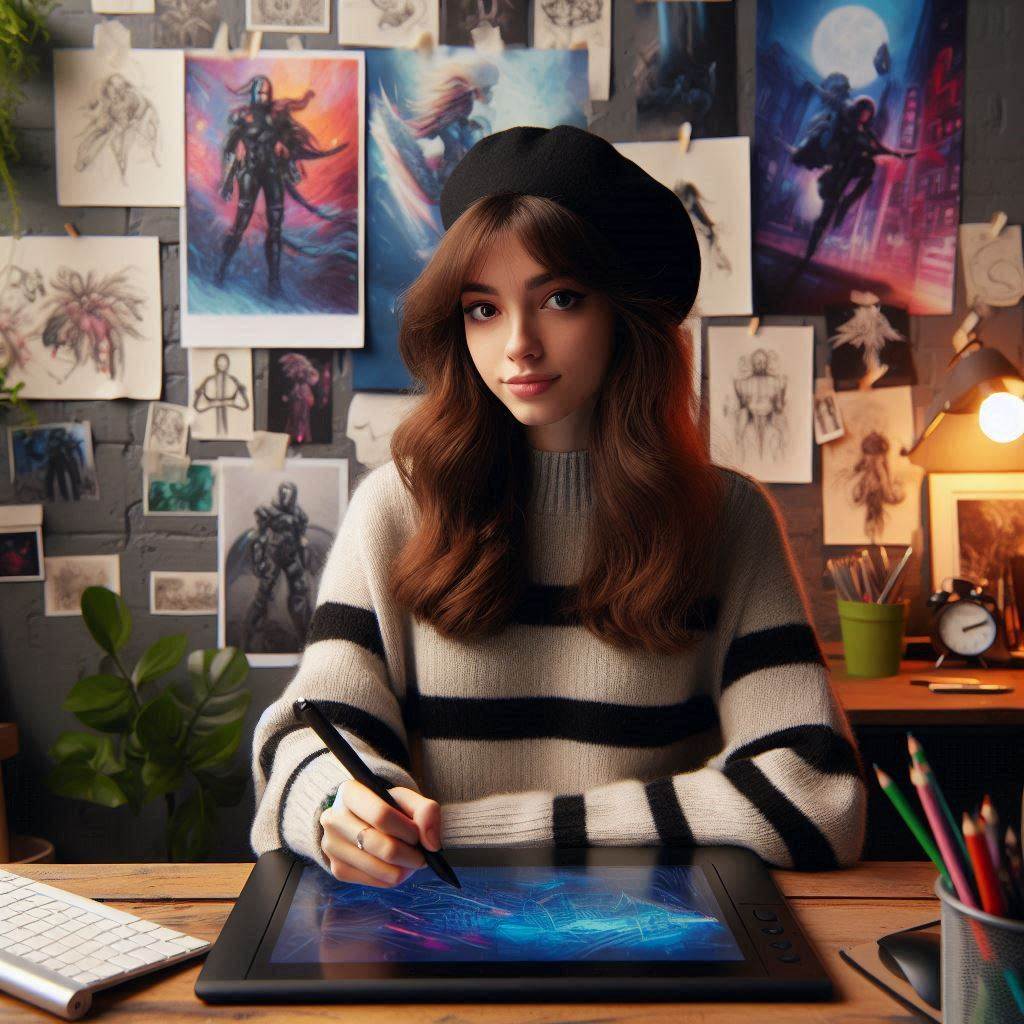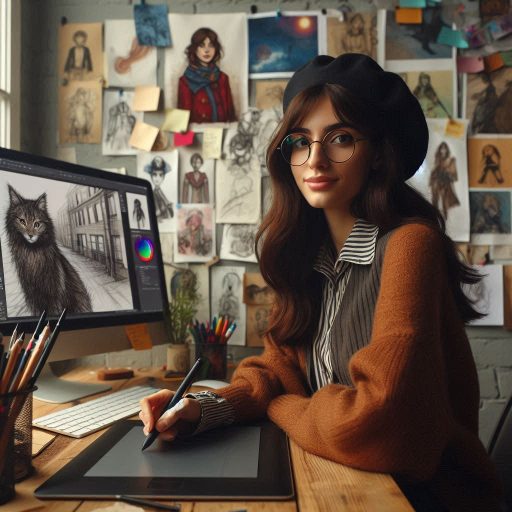Introduction
Concept art is a vital step in the creative process across various industries.
It involves visualizing ideas and concepts before they evolve into final products.
Artists use sketches, illustrations, and digital tools to create compelling visual representations of characters, environments, and objects.
This practice not only helps artists express their creative visions but also serves as a foundation for projects in film, video games, and animations.
By providing visual guidelines, concept art allows creative teams to communicate their ideas effectively and make informed decisions.
The importance of concept art in the creative industry cannot be overstated.
It drives innovation and creativity, shaping how stories are told visually.
Concept art enables directors, designers, and producers to explore different styles, aesthetics, and narratives before committing to a final design.
This exploration fosters a collaborative environment, encouraging input from various team members and stakeholders.
Additionally, concept art plays a crucial role in aligning the team’s vision.
It ensures that everyone involved, from writers to animators, shares a common understanding of the project’s direction.
By providing clear visual references, concept art minimizes miscommunication and streamlines the creative workflow.
Overview of inspiring concept art projects
Different Types of Concept Art Projects
Film and Animation Projects
Film and animation heavily rely on concept art to bring stories to life.
Artists create character designs, environment concepts, and key visuals that guide production teams.
A notable example is the work of Art Adams for The Lord of the Rings trilogy.
His intricate designs helped establish the visual identity of Middle-earth.
Adams crafted detailed sketches of iconic characters and breathtaking landscapes, setting the tone for the films.
Video Game Projects
The gaming industry is another realm where concept art shines.
It provides a blueprint for game worlds and characters.
One renowned concept artist is Feng Zhu, known for his work on Star Wars: The Old Republic.
His futuristic designs and environments created an immersive gaming experience.
Zhu’s ability to blend creativity with technical skills sets him apart in the industry.
Illustration and Book Covers
Concept art also plays a significant role in book publishing. Illustrators create cover art that captures the essence of a story.
For instance, renowned artist Brian Froud has illustrated several fantasy books, including The Dark Crystal.
His unique style and imaginative characters draw readers into the world he creates.
Froud’s work demonstrates how concept art can transcend media, enchanting audiences in multiple formats.
Product Design
Concept art extends beyond entertainment; it is essential in product design as well.
Designers create visual representations of new products before they are manufactured.
A prime example is the work of Apple’s design team.
They use concept art to explore and visualize new product ideas, ensuring functionality and aesthetics align.
This approach has led to iconic products like the iPhone and MacBook.
Environmental and Character Concepts
Environmental and character concept art are fundamental in establishing the overall aesthetic of a project.
Artists like Mike Hill have gained recognition for their environment concepts in various video games.
Hill’s detailed landscapes and atmospheric designs transport players into vibrant worlds.
Similarly, character concept artist Kazu Kibuishi creates expressive designs for various projects, including Amulet.
His characters are relatable and dynamic, showcasing the emotional depth of storytelling.
Examples of Well-Known Concept Artists and Their Work
These examples illustrate the versatility of concept art across industries.
Each project showcases unique skills, styles, and creative visions.
Well-known artists bring their distinct approaches to their work, inspiring future generations of concept artists.
Through their contributions, they shape visual narratives and enhance the audience’s experience in gaming, film, literature, and product design.
Concept art remains a vital aspect of creativity, driving innovation and inspiring new ideas.
Whether in film, games, or other media, the impact of concept art continues to resonate.
Case Study: Concept art for video games
Concept art plays a crucial role in the development of video games, serving as the visual blueprint for the game’s world, characters, and overall aesthetic.
It helps solidify the creative vision of the game designers and provides a reference point for the development team.
The role of concept art in game development
Concept art serves as the starting point for creating the visual elements of a video game.
It sets the tone, style, and atmosphere of the game, helping to establish a cohesive look and feel throughout the project.
Without concept art, developers would struggle to communicate their ideas effectively and might end up with an inconsistent or unappealing final product.
Concept artists work closely with game designers and developers to bring their ideas to life.
They use their artistic skills to create detailed illustrations of characters, environments, props, and other elements that will appear in the game.
These illustrations act as references for the 3D modelers, animators, and texture artists who will ultimately translate them into the game world.
Successful video game concept art projects
Several video games stand out for their exceptional concept art, which has played a significant role in their success.
Games like “The Witcher 3: Wild Hunt,” “Uncharted 4: A Thief’s End,” and “Horizon Zero Dawn” are celebrated for their stunning visuals, which were realized through the efforts of talented concept artists.
- “The Witcher 3: Wild Hunt” – This open-world RPG features richly detailed environments, lifelike characters, and fantastical creatures, all brought to life by the game’s concept artists.
- “Uncharted 4: A Thief’s End” – The final installment in the popular action-adventure series boasts breathtaking landscapes, intricate puzzles, and dynamic characters, all beautifully designed by the game’s concept art team.
- “Horizon Zero Dawn” – Set in a post-apocalyptic world ruled by robotic dinosaurs, this game wowed players with its unique setting, imaginative machines, and compelling characters, all visualized through stunning concept art.
Interview with a concept artist working in the gaming industry
To gain insight into the world of concept art for video games, we spoke with Sarah Nguyen, a concept artist at a leading game development studio.
With years of experience in the industry, Sarah shared her thoughts on the importance of concept art and how it influences the final look of a game.
What role does concept art play in the development of video games?
Sarah
Concept art is essential in establishing the visual identity of a game.
It helps shape the world, characters, and overall aesthetic, setting the tone for the entire project.
How does concept art contribute to the success of a video game?
Sarah
Good concept art can captivate players, drawing them into the game’s universe and making the experience more immersive.
It also guides the development team in creating a cohesive and visually striking game.
What advice do you have for aspiring concept artists looking to break into the gaming industry?
Sarah
Practice your skills consistently and build a strong portfolio that showcases your unique style and versatility.
Networking with industry professionals and staying up-to-date on industry trends are also crucial for success.
In general, concept art is a vital component of video game development, shaping the visual identity of games and influencing player experiences.
By highlighting successful projects and interviewing industry professionals, we can gain a deeper understanding of the impact of concept art in the gaming industry.
Read: Top Skills Needed for Art Educators and Instructors
Transform Your Career Today
Unlock a personalized career strategy that drives real results. Get tailored advice and a roadmap designed just for you.
Start NowCase Study: Concept art for movies and TV shows
Concept art plays a crucial role in the visual storytelling of movies and TV shows.
It serves as the initial stage where ideas and visions are transformed into visual representations.
Without concept art, it would be challenging for filmmakers to communicate their vision to the rest of the production team.
Importance of concept art in visual storytelling
- Helps in visualizing ideas: Concept art serves as a blueprint for the overall look and feel of a project, providing a visual reference for everyone involved.
- Aids in decision-making: By creating concept art, filmmakers can make important decisions regarding the design, color palette, and overall aesthetics of a film or TV show.
- Streamlines production process: Concept art helps in streamlining the production process by giving the production team a clear direction to follow.
- Inspires creativity: Concept art inspires creativity and allows artists to explore different visual styles and design choices.
Famous concept art used in movies and TV shows
Many iconic movies and TV shows have relied on stunning concept art to bring their worlds to life.
From the intricate designs of spaceships in Star Wars to the elaborate costumes in Game of Thrones, concept art has played a crucial role in shaping the visual identity of these projects.
One of the most famous examples of concept art in movies is the work done by Ralph McQuarrie for the original Star Wars trilogy.
His concept art helped George Lucas visualize the world of Star Wars and set the tone for the entire franchise.
In the world of TV shows, Game of Thrones stands out for its detailed concept art that brought the Seven Kingdoms to life.
The concept art for the show’s iconic locations, such as King’s Landing and Winterfell, played a crucial role in creating the grandeur and scale of the series.
Behind-the-scenes look at the creation of concept art for a popular film or series
Let’s take a behind-the-scenes look at the creation of concept art for the blockbuster movie, Avatar.
The film’s director, James Cameron, worked closely with concept artists to design the lush and vibrant world of Pandora.
The concept art for Avatar was instrumental in shaping the alien flora and fauna of Pandora, as well as the intricate details of the Na’vi culture.
Through detailed sketches and paintings, the concept artists brought Cameron’s vision to life and laid the groundwork for the film’s groundbreaking visual effects.
From initial sketches to final renderings, the concept art for Avatar played a crucial role in creating a visually stunning world that captivated audiences around the globe.
Without the talented concept artists behind the scenes, Avatar would not have been the visual spectacle that it is today.
Generally, concept art is an integral part of the visual storytelling process in movies and TV shows.
It helps filmmakers visualize their ideas, make important design decisions, and inspire creativity.
The analysis of famous concept art showcases its impact on iconic projects, while a behind-the-scenes look gives us insight into the intricate process of creating concept art for blockbuster films and series.
Read: Collaborating with Other Creative Roles

Case Study: Concept art for animation
Unique Characteristics of Concept Art in Animation
Concept art plays a pivotal role in animation, setting the visual tone for films and series.
It serves as a blueprint, guiding the artistic direction and style.
One unique characteristic of concept art in animation is its emphasis on storytelling.
Artists must convey emotions and narratives through visuals, creating compelling characters and environments.
Another defining aspect is the vibrant color palettes used to evoke specific feelings.
These colors help establish mood and atmosphere, engaging the audience from the outset.
Additionally, concept art in animation often incorporates various styles and techniques.
Artists experiment with shapes and forms to develop distinct characters and worlds.
This creative freedom allows them to push boundaries and explore innovative ideas.
The iterative process is crucial in animation, as artists frequently revise their designs based on feedback.
Each iteration refines the visuals, enhancing the overall quality of the animation project.
Showcasing Concept Art from Beloved Animated Films and Series
Several beloved animated films and series showcase outstanding concept art that captivates audiences.
For example, Disney’s Frozen features stunning concept art that beautifully captures the icy landscapes of Arendelle.
The artists created detailed sketches of characters like Elsa and Anna, highlighting their personalities and relationships.
This concept art played a significant role in shaping the film’s emotional depth and visual style.
Similarly, Studio Ghibli films like Spirited Away display breathtaking concept art that transports viewers to fantastical worlds.
The meticulous designs of characters and environments contribute to the film’s enchanting atmosphere.
Concept art for Toy Story showcases the evolution of characters like Woody and Buzz Lightyear, revealing how their designs evolved throughout the production process.
Interview with a Concept Artist Specializing in Animation
To gain insights into the world of animation concept art, we interviewed a talented concept artist specializing in this field.
[Artist Name], who has worked on projects like [Project Title], shared their creative journey.
They emphasized the importance of research and inspiration in the concept art process.
“I draw from various sources, including nature and everyday life,” they explained.
“This helps me create authentic and relatable characters.”
When asked about the challenges in animation concept art, they highlighted the need for collaboration.
“Working closely with directors and animators is essential,” they said.
“Their feedback shapes the final designs and ensures everything aligns with the vision.
” The artist also discussed the joy of seeing their concepts come to life on screen.
“It’s incredibly rewarding to witness your designs in action,” they added.
“It feels like a dream come true.”
Ultimately, concept art in animation possesses unique characteristics that enhance storytelling and visual appeal.
By showcasing inspiring projects and featuring insights from industry professionals, we celebrate the incredible work of concept artists in animation.
Their creativity and dedication continue to shape beloved animated films and series, captivating audiences worldwide.
Read: Breaking Down Iconic Movie Costumes
Case Study: Concept art for theme park design
Concept art plays a vital role in theme park planning.
It shapes the overall vision and aesthetic of the park.
Designers use concept art to visualize ideas and themes before construction begins.
This early visual representation helps stakeholders understand the project’s direction.
It also allows for adjustments before any physical work starts.
Concept art enables a seamless blend of storytelling and design, essential for creating immersive experiences.
The Role of Concept Art in Theme Park Planning
In theme park development, concept art serves as a blueprint for creativity.
Artists create illustrations that depict attractions, landscapes, and characters.
These images capture the essence of the park’s theme and ambiance.
They guide architects and engineers in constructing the envisioned spaces.
Concept art can also communicate complex ideas in a digestible format.
This is especially crucial when presenting concepts to investors and collaborators.
Showcase Your Business Today
Reach thousands of readers actively exploring professional services. Publish your business profile and grow your audience now.
Publish NowThe planning phase often involves brainstorming sessions with various departments.
Concept artists collaborate closely with creative directors, designers, and marketing teams.
This teamwork ensures that the final designs align with the intended audience’s expectations.
As a result, the park can evoke specific emotions and experiences for its visitors.
Concept art thus functions as a bridge between imagination and reality.
Showcasing Concept Art for Well-Known Theme Parks
Many well-known theme parks have leveraged concept art to great success.
For instance, Disneyland often showcases its concept art during park announcements.
The stunning visuals build excitement for upcoming attractions.
Universal Studios uses concept art to create immersive environments that transport guests to different worlds.
Their attention to detail in artwork sets the tone for the park experience.
One remarkable example is the Wizarding World of Harry Potter at Universal Studios.
Concept art played a crucial role in designing this highly detailed area.
Artists meticulously crafted visuals that captured the magic and whimsy of J.K. Rowling’s universe.
These illustrations influenced every aspect of the design, from attractions to shops.
Visitors experience the feeling of stepping into the beloved story.
Interview with a Concept Artist Involved in Theme Park Design
To gain deeper insights, we interviewed a seasoned concept artist involved in theme park design.
She emphasized the importance of collaboration.
“Working with various teams brings diverse ideas to the table,” she said.
“Each project teaches me something new about blending art with functionality.”
When asked about her favorite project, she mentioned a recent theme park expansion.
“Creating the concept art was exhilarating,” she explained. “Seeing it come to life was incredibly rewarding.”
This passion for her work highlights the significance of concept art in crafting unforgettable experiences for theme park visitors.
In review, concept art significantly impacts theme park planning.
It transforms imaginative ideas into visual narratives that guide the design process.
By showcasing remarkable projects and featuring artists’ insights, we see how concept art shapes the magic of theme parks.
Read: Networking Events for Costume Designers
The creative process behind concept art
Steps Involved in Creating Concept Art
The first step in creating concept art is research.
Artists study the project’s themes, settings, and character details.
Gathering references helps them visualize their ideas and understand the context.
After research, artists move to brainstorming.
This stage involves sketching multiple ideas rapidly, allowing creative thoughts to flow freely.
Artists often create thumbnails to explore different compositions and concepts quickly.
Next, artists select their best sketches and move on to refinement.
During this stage, they add details, define shapes, and clarify forms.
This step is crucial, as it helps convey the concept more clearly.
After refinement, artists create a final piece.
This involves rendering the artwork with color, lighting, and textures.
Artists utilize digital painting techniques or traditional media, depending on their preferences and project requirements.
Tools and Techniques Used by Concept Artists
Concept artists rely on various tools and techniques to bring their ideas to life.
Digital software such as Adobe Photoshop and Corel Painter are industry standards.
These programs offer powerful features for painting, drawing, and editing.
Additionally, many artists use graphic tablets for precise control over their strokes.
Tablets enable artists to create more fluid and dynamic artwork.
Some concept artists also explore 3D modeling software like Blender or ZBrush.
These tools allow them to visualize complex shapes and structures, adding depth to their designs.
Furthermore, artists often utilize color theory and composition techniques to enhance their visual storytelling.
Understanding how colors interact can significantly impact the mood of a piece.
Tips for Aspiring Concept Artists to Improve Their Skills
Aspiring concept artists can take several steps to enhance their skills.
Practice regularly. Set aside time each day to draw and experiment with new techniques.
This habit builds confidence and develops artistic style.
Additionally, study anatomy and perspective.
Understanding these fundamentals is essential for creating believable characters and environments.
Another valuable tip is to seek feedback.
Sharing work with peers or mentors can provide constructive criticism and fresh perspectives.
Join online communities or attend workshops to connect with other artists.
Analyze existing concept art to understand different styles and approaches.
Look at industry professionals’ work to learn about trends and techniques.
Finally, don’t hesitate to explore various mediums.
Trying different styles, from digital painting to traditional sketching, can unlock new creative avenues.
Embrace experimentation and allow yourself to make mistakes.
Learning from these experiences will ultimately enhance your artistic journey.
In summary, creating concept art is a structured process that involves research, brainstorming, refinement, and finalization.
Utilizing the right tools and techniques is vital for success.
Aspiring artists should practice regularly, seek feedback, and explore various styles to continually improve their skills.
Conclusion
Concept art plays a vital role across various industries, including gaming, film, and animation.
It serves as the foundation for visual storytelling, guiding creative direction and enhancing overall design.
Concept art is essential for developing characters, environments, and objects, ensuring they align with the project’s vision.
The importance of concept art cannot be overstated, as it shapes the viewer’s experience and engages audiences on multiple levels.
The process of creating concept art encourages artists to explore their imagination and push the boundaries of their creativity.
I encourage you to delve into this dynamic field, whether you’re an aspiring artist or a seasoned professional.
Experiment with different styles, techniques, and mediums to find your unique voice.
Embrace the challenges that come with concept art, as they often lead to personal growth and artistic development.
Furthermore, consider collaborating with other artists or participating in online challenges to broaden your skills.
Engaging with the art community can provide valuable feedback and inspiration.
Finally, I invite you to share your favorite concept art projects, whether they inspire you or represent your own work.
[E-Books for Sale]
The Big Book of 500 High-Paying Jobs in America: Unlock Your Earning Potential
$19.99 • 500 High-Paying Jobs • 330 pages
Explore 500 high-paying jobs in America and learn how to boost your career, earn more, and achieve success!
See All 500 High-Paying Jobs of this E-Book
1001 Professions Without a Degree: High-Paying American Jobs You Can Start Now
$19.99 • 1001 Professions Without a Degree • 174 pages
Discover 1001 high-paying jobs without a degree! Unlock career tips, skills, and success strategies for just $19.99!




